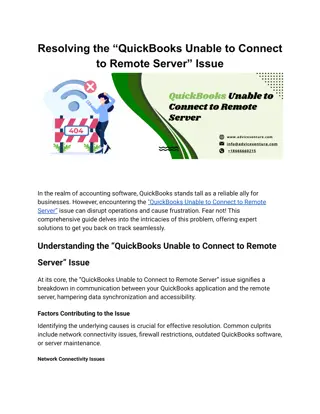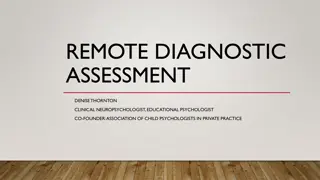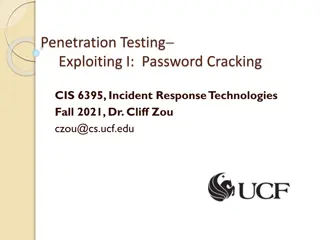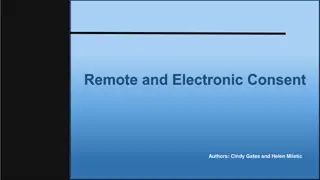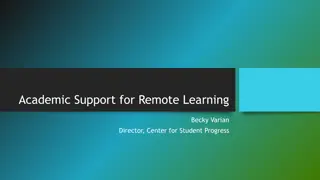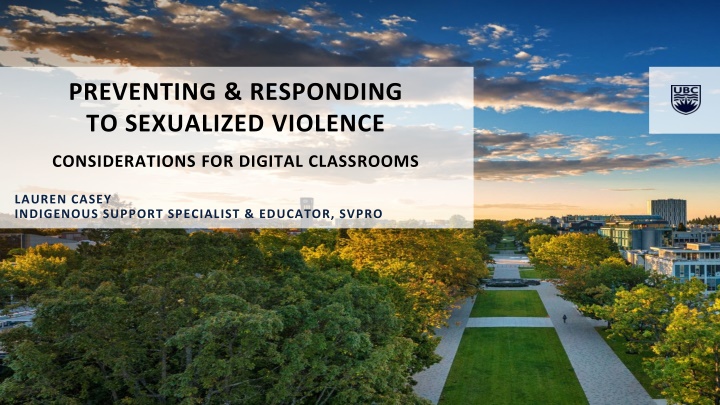
Supporting Safety in Digital Classrooms: Strategies for Preventing and Addressing Sexualized Violence
Explore considerations for preventing and responding to sexualized violence in digital classrooms, covering topics such as trauma-informed responses, creating safe online environments, and the importance of content notes. Understand the significance of trigger warnings and promoting a respectful environment in educational settings.
Uploaded on | 3 Views
Download Presentation

Please find below an Image/Link to download the presentation.
The content on the website is provided AS IS for your information and personal use only. It may not be sold, licensed, or shared on other websites without obtaining consent from the author. If you encounter any issues during the download, it is possible that the publisher has removed the file from their server.
You are allowed to download the files provided on this website for personal or commercial use, subject to the condition that they are used lawfully. All files are the property of their respective owners.
The content on the website is provided AS IS for your information and personal use only. It may not be sold, licensed, or shared on other websites without obtaining consent from the author.
E N D
Presentation Transcript
PREVENTING & RESPONDING TO SEXUALIZED VIOLENCE CONSIDERATIONS FOR DIGITAL CLASSROOMS LAUREN CASEY INDIGENOUS SUPPORT SPECIALIST & EDUCATOR, SVPRO
PLAN FOR TODAYS SESSION Creating & Using Content Notes Trauma-Informed Responses to Disclosures of Sexualized Violence Providing Remote Support Preventing & Responding to Sexualized Violence in Online Teaching & Learning Spaces 2
What is a CONTENT NOTE? Also Known As TRIGGER WARNING We don t know someone s story you should be aware of the potential to cause harm & proactively work to prevent it Content Note: the examples on the next page of this document include brief descriptions of a please be aware as you engage this document; if you wish to avoid the example, use the alternate version of this document. 3
Who, When, Why, & How? WHO: should be received by EVERYONE WHEN: in ADVANCE We don t know someone s story you should be aware of the potential to cause harm & proactively work to prevent it WHY: ensuring those impacted can make the best decision for their WELLBEING and SAFETY HOW: syllabus, course schedule, by email, in person (live) Consider ALTERNATIVE OPTIONS 4
REFLECTION AND PRACTICE Consider moments in your curricula where a content note might be appropriate. Anyone open to sharing? 5
UBC Statement on Respectful Environment The best possible environment for working, learning and living is one in which respect, civility, diversity, opportunity and inclusion are valued. Everyone at the University of British Columbia is expected to conduct themselves in a manner that upholds these principles in all communications and interactions with fellow UBC community members and the public in all University-related settings. 6
CREATING SAFE ONLINE ENVIRONMENTS Addressing Language/Behaviour: words or actions that disparage people or groups of people or that minimizes, belittles, or advocates for violence may be sexual misconduct or discrimination What can you do? Establish clear standards, especially for group work Use online platforms for collaboration that you can monitor Use forums only when active moderation is possible Address violent or harassing language when it occurs 7
REFLECTION AND PRACTICE What are your standards for acceptable and unacceptable language and communication? How do you communicate them to your students? 8
TRAUMA-INFORMED RESPONSE to DISCLOSURES Understand Your Role: Disclosure vs. Reporting Focus on your role as a part of the SUPPORT system, NOT the reporting system SVPRO = Refer Disclosures (UBC has a separate office for reporting purposes Investigations Office if the survivor wishes to report, SVPRO can refer them & support them through that process with the IO) 9
TRAUMA-INFORMED RESPONSE to DISCLOSURES Don t Investigate Express Belief Don t Victim Blame Validate Feelings Don t Minimize We can create a culture that believes & supports survivors in the way we respond to disclosures Your GOAL is to return CHOICE & CONTROL to the survivor including whether they seek support 10
Sexual Violence Prevention & Response Office @ UBC svpro.vancouver@ubc.ca 604.822.1588 4071 6363 Agronomy Rd. (Orchard Commons 4th Floor) 11
HOW IS REMOTE SUPPORT DIFFERENT? People may be in closer proximity with those who have caused them harm/are causing them harm & Privacy concerns are heightened What can you do when checking in with a student? Use Neutral Subject Line Indicate to Read in Safe/Private Place Easy Way to Indicate Safety Concern Provide Info in Normalized Context Offer Multiple Ways to Connect Indicate Remote Support is Available 12
REFLECTION AND PRACTICE For each of the following scenarios, discuss what you would say/write and do in response. 13
CONTENT NOTE: the following scenarios include examples of disclosures of sexualized violence (without details/descriptions of incidents or acts) and a classroom incident including language that is dismissive/minimizing of serious violence 14
SCENARIO ONE A faculty member is grading assignments. One assignment has a section of analysis critiquing some types of justice system interactions with people who have been targeted by sexual assault. In that paper, the student describes them self as a survivor of ongoing sexualized violence . The faculty member s usual practice is to upload comments and a grade to Canvas in response to the students assignment. 15
SCENARIO TWO Students are popping into Collaborate before this week s lecture, which is the first since the mid term exam. In the chatbox, students are discussing the exam, recalling questions that they found challenging. One student posts The questions were rugged. That exam harsh raped me. A few other students respond with thumbs up and laughing emojis. 16
SCENARIO THREE A student has emailed you to ask for an extension on an assignment. You write back asking how long they need and why, and in response the student discloses to you that they have been impacted by sexualized violence and are currently scared and struggling with their mental health. Your response includes an indication to read in a private place, and the student replies no, indicating they can t currently access a safe or private place. 17
REFLECTION Do you have any questions, concerns, thoughts? 18
Connect with SVPRO for RESOURCES & SUPPORT Lauren Casey Lauren.Casey@ubc.ca SVPRO Email: svpro.vancouver@ubc.ca Phone Number: 604.822.1588 19



